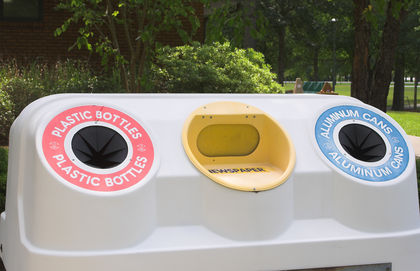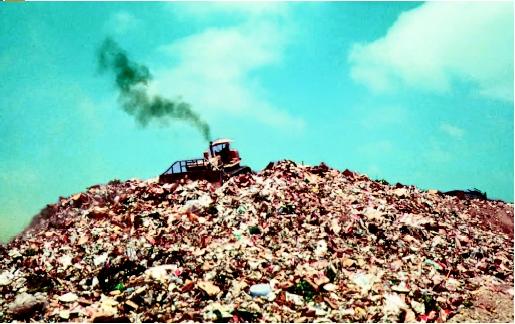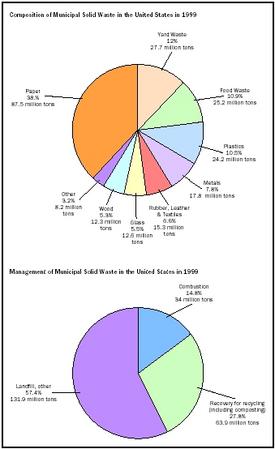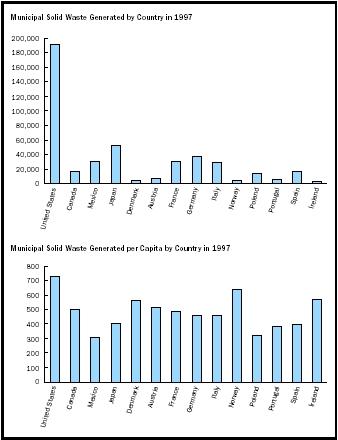Solid Waste

The garbage that is managed by local governments is known as municipal solid waste (MSW). Specifically, MSW is waste generated by commercial and household sources that is collected and either recycled, incinerated, or disposed of in MSW landfills. The U.S. Environmental Protection Agency (EPA) separates MSW into several categories, including containers and packaging, yard wastes, durable goods, and nondurable goods. Examples of

During the 1980s, solid waste management issues emerged in the United States due to the increasing amounts of solid waste generated, shrinking landfill capacity, rising disposal costs, and strong opposition to the siting of new solid waste facilities. This problem was illustrated by the much-publicized Mobro garbage barge, which traveled on a six-month odyssey before the garbage was finally disposed of in New York state, where it was originally generated.
With millions of households and businesses generating garbage in the United States, developing a national management program is challenging. Instead of federal regulations dictating how solid wastes should be managed, solid-waste programs are managed by states and municipalities on the local level according to individual community needs. With the exception of federally mandated landfill design and operating criteria to ensure the protection of groundwater and requirements for the federal purchase of products containing recovered materials, the EPA's role in implementing solid-waste management programs includes setting national goals, providing leadership and technical assistance, and developing educational materials.
MSW Stream
The generation of MSW has grown steadily over the past thirty years, from 88 million tons per year, or 2.7 pounds per person per day in 1960, to 229.9 million tons, or 4.62 pounds per person per day in 1999. The largest component of the MSW stream is paper and paperboard products (38.1%), with yard trimmings the second most predominant component (12.1%). The top of two pie charts on the next page breaks down this waste by material category. While the generation of waste has grown steadily, so too have its recycling and recovery. In 1960 about 7 percent of MSW was recycled, and in 1999 this figure had increased to 27.8 percent. How MSW is managed is shown in the bottom of two pie charts on the next page. Although the majority of solid waste is still sent to landfills, statistics indicate that there is a clear trend away from reliance on this method. Combustion of MSW and recovery through recycling are now a common practice in the United States.
MSW Management
In response to mounting solid waste problems, EPA published The Solid Waste Dilemma: An Agenda for Action in 1989, which presents goals and recommendations for action by the EPA, state and local governments, industry, and consumers to address the solid waste problems facing the United States. The EPA recommends an integrated, hierarchical approach to waste management using four components: source reduction, recycling, combustion, and landfills. This comprehensive approach addresses critical junctures in the manufacture, use, and disposal of products and materials to minimize wastefulness and maximize value. This strategy favors source reduction to decrease the volume and toxicity of waste and to increase the useful life of products. After source reduction, recycling, including composting, is the preferred waste management approach to divert waste from combustors and landfills. Combustion is used to reduce the volume of waste being disposed as well as to recover energy, whereas landfills are used for the final disposal of nonrecyclable and noncombustible material.
The goal of the integrated management hierarchy is to use a combination of all these methods to handle the MSW stream safely and effectively with the least adverse impact on human health and the environment. The EPA encourages communities to develop community-specific assessments of potential source reduction, recycling, combustion, and landfill programs and to customize programs according to local needs, keeping in mind the strategies preferred in the national hierarchical structure. Because each community's waste profile (i.e., the amounts and types of waste generated), infrastructure, social and economic structure, and policies differ, decision makers at the local level are the most qualified to assess community needs and develop an appropriate solid waste management strategy.
Source Reduction
Source reduction, also known as waste prevention, is a front-end approach to addressing MSW problems by changing the way products are made and used.

Recycling
Recycling refers to the separation and collection of wastes and their subsequent transformation or remanufacture into usable or marketable materials. Recycling, including composting, diverts potentially large volumes of material from landfills and combustors, and prevents the unnecessary waste of natural resources and raw materials. Other environmental benefits offered by recycling include a reduction in greenhouse gas emissions, energy conservation, and the preservation of biodiversity and habitats that would otherwise be exploited for virgin materials. In addition, recycling programs create new manufacturing jobs, boost the economy, and facilitate U.S. competitiveness in the global marketplace.
Like any other part of the integrated waste management hierarchy, recycling programs should be carefully designed and implemented to address the needs of the community, including attention to their cost-effectiveness. Recycling collection and separation programs vary in degree of implementation: Some may be simple drop-off programs, whereas others may involve comprehensive curbside collection and complex source separation at a recovery facility. Successful recycling, however, requires more than the separation and collection of postconsumer materials. Recycling programs must identify and develop markets for recovered material; only when the materials are reused is the recycling loop complete.
Although markets and uses for recovered materials are constantly expanding, reuse opportunities will vary by material. For example, recycling options for plastic are contingent on the type of resin used. Soft drink bottles are currently incorporated into products such as carpeting, household cleaner bottles, and fiberfill for coats and pillows, whereas polystyrene food containers and cups are being recycled into insulation, cafeteria food trays, and children's toys. Depending on their condition, tires can be used for artificial reefs, playground equipment, floor mats, and road construction materials. Recycled-content newspapers, stationery, corrugated containers, and toilet paper are some examples of how discarded paper is recycled.
Recycling activities also include centralized composting of yard and food wastes. Composting refers to the controlled decomposition of organic matter by microorganisms into a stable humus material that is used primarily on the land to improve soil quality. Many communities conduct large-scale centralized composting of yard waste in an effort to save landfill capacity. Individuals are also helping to reduce waste by composting yard waste in their backyards, and by not bagging grass clippings or other yard wastes—these activities are actually classified as source reduction. The composting of yard waste has seen tremendous growth in the past ten years. In 1980 the amount of yard waste recovered was negligible (less than 5,000 tons, or 0.05%). By 1999 the amount of yard waste recovered had grown to 12.6 million tons, or 45.3 percent.
Combustion
Burning has been a popular method of reducing the volume and odor of garbage for centuries. With the onset of the 1970s energy crisis and the Clean Air Act, a more sophisticated system of incineration was developed that could use waste as a fuel to produce energy. Modern combustion facilities no longer just destroy garbage, but instead are designed to recover energy that is used to produce steam and electricity. Developing a successful waste-to-energy system involves numerous decisions that will dictate whether such a project is effective in a given community. Over the past two decades communities have demonstrated an increased interest in combustion as a waste management option. Between 1980 and 1999, the combustion of solid waste increased 5.8 percent, with approximately 2.6 million tons of MSW burned in 1999. In addition to the benefits of energy recovery, combustion residues consume less landfill space; combustion ash amounts to approximately 25 percent (dry weight) of the MSW input. However, citizens often oppose the building of incinerators close to communities and farmland because of the perception of health risks due to emission of pollutants including mercury and dioxin that are toxic, persistent, and bioaccumulate.
Landfills
Even with the use of source reduction, recycling, and combustion, there will always be waste that ultimately must be disposed of in landfills. According to the EPA's Municipal Solid Waste in the United States: 1999 Facts and Figures, landfill disposal still remains the most widely used waste management method (accounting for approximately 57.4% of the total). Many communities now face difficulties siting new landfills largely because of increased citizen and local government concerns about the potential health risks and aesthetics of situating a landfill in their neighborhoods. The EPA issued new technical standards for MSW landfills in 1991. These addressed several aspects of landfill management, including location restrictions, design and operating criteria, and groundwater monitoring. Even with national landfill standards, decreasing landfill capacity and the difficulties associated with the construction of new landfills remain significant issues.
The EPA has explored several solutions to conserving landfill capacity, including the viability of engineering materials such as plastics to be less resistant to degradation or, in other words, biodegradable. Biodegradable materials can be broken down into simpler substances (e.g., elements and compounds) by bacteria or other natural decomposers. Paper and most organic wastes such as food and leaves are biodegradable. In contrast, nonbiodegradable substances cannot be broken down in the environment by natural processes. In general, degradation in landfills occurs very slowly due to modern landfill design criteria, which minimize waste exposure to sunlight, air, and moisture. In fact, even biodegradable organic materials might take decades to decompose in a landfill; carrots and cabbage have been discovered in recognizable form after several years of burial. Studies indicate that biodegradable materials may help diminish risks to wildlife and aesthetic damage (i.e., discarded six-pack beverage rings and wrappers), but will not reduce the volume or toxicity of waste nor provide a solution to decreasing landfill capacity.
In continuing efforts to conserve landfill space and reduce waste toxicity, the EPA is currently investigating the potential benefits and drawbacks associated with the use of bioreactor landfills. Bioreactor landfills are designed to transform and more quickly stabilize the decomposable organic constituents of the waste stream through the controlled injection of liquid or air to enhance microbiological degradation processes. In other words, by controlling the moisture content, bioreactor landfills facilitate microbial decomposition of waste. Recent findings show that bioreactor landfills successfully expedite the degradation process (e.g., from decades to years), offer a 15 to 30 percent gain in landfill space, and may reduce postclosure care and leachate disposal costs. In addition, the bioreactor technology significantly increases landfill gas emissions, which are captured and often used beneficially for energy recovery. Due to their complexity, however, bioreactor landfills may be more costly, and concerns have been raised regarding increased odors, liner instability, and surface seeps. Working in conjunction with state and local governments and private companies, the EPA has initiated several research and pilot projects to examine the effectiveness of this innovative technology.
International Solid Waste Management
Because solid waste is generated everywhere, addressing the environmentally safe management of solid waste is not limited to the United States. Management strategies vary by country and region, although most programs address waste issues with models consisting of some combination of source reduction, combustion, recycling, and landfills. For example, the European Environment Agency (EEA) offers solid-waste management guidance analogous to EPA's integrated hierarchy. Specifically, the Community Strategy on Waste recommends that the agency's eighteen-member countries make waste prevention their top priority, followed by materials recovery, energy recovery, and, finally, the safe disposal of waste.
The international Organisation for Economic Co-operation and Development (OECD) compiles worldwide data, including environmental statistics, for its thirty member countries. The bar graphs on the next page compare the total amount of municipal waste generated annually and the annual amount of municipal waste generated per capita, respectively, by the United States and other selected OECD member countries in 1997. Per capita waste generation rates vary significantly by country; factors contributing to such discrepancies may include individual lifestyle and national economic structure. Although individual national definitions may differ, for the purpose of analysis here, OECD regards municipal waste as waste collected by or on the order of municipalities, including that originating from households, commercial activities, office buildings, institutions such as school and government buildings, and small businesses.
The environmentally safe management of municipal solid waste may always be an issue, simply because societies will continue to generate trash due to increasing populations and the growing demands of modern society. Working together, federal, state, and local governments, industry, and citizens have made substantial progress in effectively responding to solid waste

SEE ALSO C OMPOSTING ; I NCINERATION ; L ANDFILL ; P LASTIC ; R ECYCLING ; R EUSE ; W ASTE ; W ASTE R EDUCTION .
Bibliography
Christiansen, Kim Michael. (1999). Waste Annual Topic Update: 1998. Copenhagen: European Environmental Agency.
O'Leary, Philip R., and Walsh, Patrick H. (1995). Decision Makers Guide to Solid Waste Management, Vol. II. Washington, D.C.: U.S. Environmental Protection Agency. EPA530-R95-023.
Organisation for Economic Co-operation and Development. (1999). OECD Environmental Data: Compendium 1999 Edition. Organisation for Economic Co-operation and Development.
U.S. Environmental Protection Agency. (1994). Composting Yard Trimmings and Municipal Solid Waste. Washington, D.C.: U.S. Environmental Protection Agency. EPA530-R-94-003.
(top) Comparison of annual amounts of MSW generated by the United States and other selected OECD countries in 1997. Generation amounts are in 1,000 tons. (bottom) Comparison of annual amounts of MSW generated per capita by the United States and other selected OECD countries in 1997. Generation amounts are in kilograms per capita. (Both based on statistics from OECD Environmental Data 1999.)
U.S. Environmental Protection Agency. (1990). Environmental Fact Sheet: The Facts on Degradable Plastics. Washington, D.C.: U.S. Environmental Protection Agency. EPA530-SW-90-017D.
U.S. Environmental Protection Agency. (1990). Environmental Fact Sheet: The Facts on Recycling Plastics. Washington, D.C.: U.S. Environmental Protection Agency. EPA530-SW-90-017E.
U.S. Environmental Protection Agency. (1992). "Green" Advertising Claims. Washington, D.C.: U.S. Environmental Protection Agency. EPA530-f-92-024.
U.S. Environmental Protection Agency. (1991). Markets for Scrap Tires. Washington, D.C.: U.S. Environmental Protection Agency. EPA530-SW-90-074A.
U.S. Environmental Protection Agency. (1997). Measuring Recycling: A Guide for State and Local Governments. Washington, D.C.: U.S. Environmental Protection Agency. EPA530-R-97-011.
U.S. Environmental Protection Agency. (2001). Municipal Solid Waste in the United States: 1999 Facts and Figures. Washington, D.C.: U.S. Environmental Protection Agency. EPA530-R-01-014. Also available from http://www.epa.gov/epaoswer/non-hw/muncpl/mswfinal.pdf
U.S. Environmental Protection Agency. (1999). National Source Reduction Characterization Report for Municipal Solid Waste in the United States. Washington, D.C.: U.S. Environmental Protection Agency. EPA530-R-99-034. Also available from http://www.epa.gov/epaoswer/non-hw/reduce/r99034.pdf .
U.S. Environmental Protection Agency. (1998). Puzzled About Recycling's Value? Look Beyond the Bin. Washington, D.C.: U.S. Environmental Protection Agency. EPA530-K-98-008. Also available from http://www.epa.gov/epaoswer/non-hw/recycle/benefits.pdf .
U.S. Environmental Protection Agency. (1998). RCRA Orientation Manual: 1998 Edition. Washington, D.C.: U.S. Environmental Protection Agency. EPA530-R-98-004.
U.S. Environmental Protection Agency. (1999). Recycling Works! State and Local Solutions to Solid Waste Management Problems. Washington, D.C.: U.S. Environmental Protection Agency. EPA530-K-99-003. Also available from http://www.epa.gov/epaoswer/non-hw/recycle/recycle.pdf .
U.S. Environmental Protection Agency. (1989). The Solid Waste Dilemma: An Agenda for Action. Washington, D.C.: U.S. Environmental Protection Agency. EPA530-SW-89-019.
Office of Solid Waste/U.S. Environmental Protection Agency
Comment about this article, ask questions, or add new information about this topic: